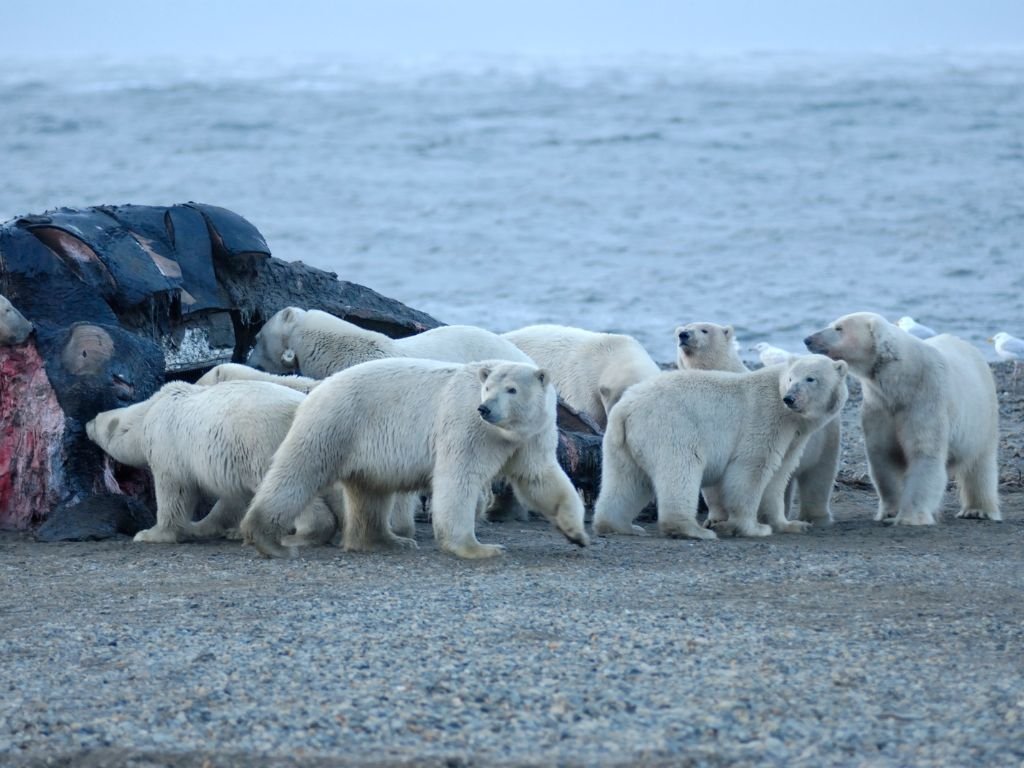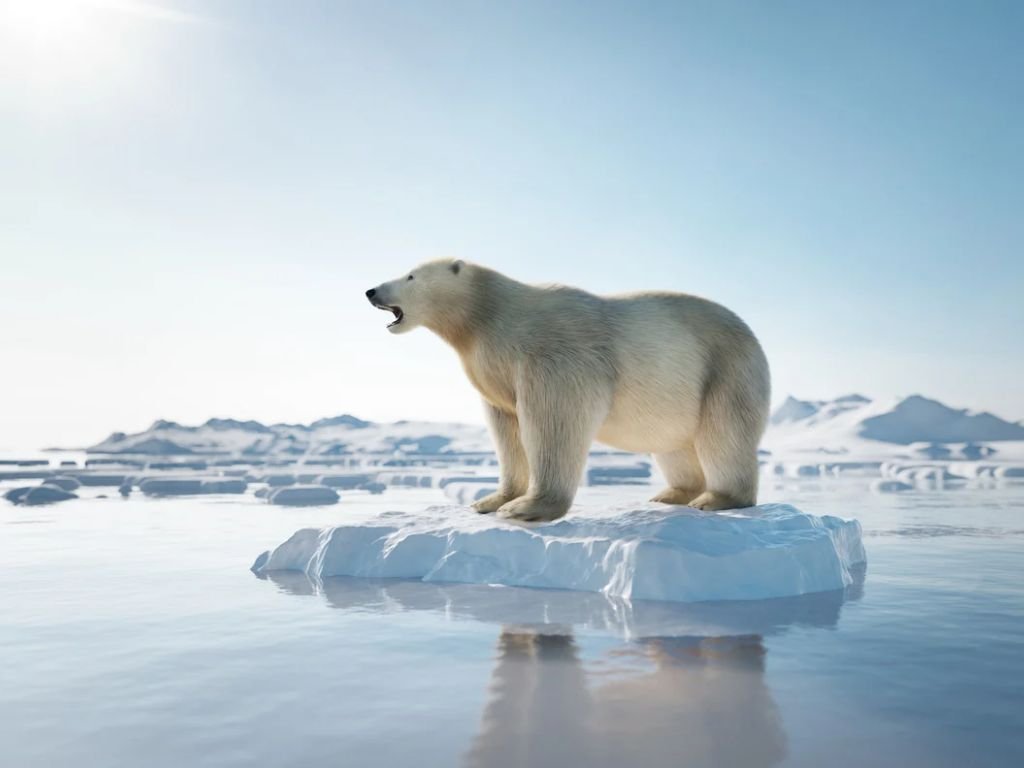Polar bears are one of the world’s most beloved animals, yet they are currently facing an uncertain future due to their status as a threatened species. Polar bears have been listed as endangered since 2008 and there is growing concern over the long-term survival of this iconic species. Lets find out why are polar bears endangered and how we can save them.
Why are polar bears endangered
Polar bears are considered to be endangered because their habitat is under threat from several factors. The primary reason for the decline in polar bear populations is climate change, which has caused significant reductions in sea ice habitat that these animals rely on for hunting and breeding grounds. Additionally, human activities such as oil exploration and shipping traffic can also lead to increased levels of pollution that further threaten polar bear populations by contaminating their food sources or leading to accidents involving collisions with ships or entanglement in fishing nets.

Polar bears are endangered due to:
1. Climate change
The most significant threat to polar bears is climate change, which is causing the Arctic sea ice to melt at an alarming rate. This is a problem for polar bears because they rely on the sea ice as a platform for hunting, mating, and traveling. As the sea ice melts, polar bears are forced to travel longer distances to find food and reproduce, which puts them at greater risk of starvation and other environmental hazards.
2. Habitat Loss
Habitat loss and fragmentation due to human activities such as oil and gas development and shipping.
3. Pollutants
Another factor contributing to the decline of polar bears is pollution. Pollutants like pesticides and heavy metals can accumulate in the tissues of polar bears and other Arctic animals, and can have harmful effects on their health and reproductive success. These pollutants can also affect the health of the polar bears’ prey, such as seals and fish, which can further reduce their food supply.

4. Overhunting
Another major threat to polar bears is overhunting. In some areas, polar bears are hunted for their fur, meat, and other body parts, which can have a significant impact on their populations. This can have a negative impact on the population of polar bears, especially if the hunting is not managed sustainably.
5. Human Interaction
In addition, as human populations continue to grow and expand into polar bear habitats, the bears are coming into more frequent contact with people, which can lead to more conflicts and a higher number of bears being killed.
How many polar bears are left in the world
It is difficult to say exactly how many polar bears are left in the world, as their populations can vary depending on factors such as habitat conditions, hunting pressures, and other factors. However, according to the World Wildlife Fund (WWF), there are an estimated 22,000-31,000 polar bears left in the world. This number includes all of the subpopulations of polar bears, which are found in five different countries: Canada, Russia, the United States (Alaska), Greenland, and Norway.
It is important to note that the polar bear is listed as a vulnerable species on the International Union for Conservation of Nature (IUCN) Red List of Threatened Species. This means that they are at risk of becoming endangered in the near future due to the various threats they face, such as habitat loss and climate change. As a result, it is important for us to take action to protect polar bears and their habitat in order to ensure their survival.

Why are polar bears important
Polar bears are important for a number of reasons. Some of the key reasons why polar bears are important include:
- Polar bears are a keystone species in the Arctic ecosystem. This means that they play a critical role in regulating the populations of other species and maintaining the overall health of the ecosystem.
- Polar bears are an important food source for many indigenous communities in the Arctic. These communities have relied on polar bears for their survival for thousands of years, and their loss would have significant cultural and economic impacts.
- Polar bears are an important part of the global climate system. As top predators in the Arctic, polar bears help to regulate the carbon cycle by consuming and storing large amounts of carbon in their bodies.
- Polar bears are an important cultural and spiritual symbol for many indigenous communities in the Arctic. For these communities, polar bears hold great significance and their loss would be a great loss to their culture.

Polar bears play a vital role in the Arctic ecosystem and are an important species for both the environment and human.
What would happen if polar bears went extinct
If polar bears were to go extinct, it would have a number of negative impacts on the environment and the other species that depend on them. Some potential consequences of polar bear extinction include:
- The loss of a top predator in the Arctic ecosystem. Polar bears play an important role in regulating the populations of other species, such as seals and fish, which are an important part of their diet. If polar bears were to go extinct, it could lead to an overabundance of these species, which could have cascading effects on the entire ecosystem.
- The loss of a keystone species. Keystone species are species that play a critical role in their ecosystem, and the loss of a keystone species can have widespread impacts on other species in the ecosystem. Polar bears are a keystone species in the Arctic, and their loss could lead to a significant disruption of the ecosystem.
- The loss of an important cultural and spiritual symbol for indigenous peoples. For many indigenous communities in the Arctic, polar bears hold a special cultural and spiritual significance. Their loss would be a great loss not only to the environment, but also to the cultures of these communities.
Overall, the loss of polar bears would have far-reaching and potentially catastrophic effects on the environment and the species that depend on them. It is important for us to take action to protect polar bears and their habitat in order to prevent their extinction.
How can we help polar bears

There are several ways that people can help polar bears, including:
- Reduce your carbon footprint: One of the biggest threats to polar bears is climate change, which is caused by the burning of fossil fuels. By reducing your own carbon footprint, you can help slow the rate of climate change and protect polar bear habitat.
- Support organizations that work to protect polar bears: There are many organizations, such as the World Wildlife Fund, that work to protect polar bears and their habitat. You can support these organizations by donating money or volunteering your time.
- Educate others: Help spread the word about the threats facing polar bears and what people can do to help. Share information about polar bears and climate change with your friends and family, and encourage them to take action to protect these animals.
- Be a responsible traveler: If you plan to visit areas where polar bears live, be sure to do so in a responsible way. Follow local guidelines and regulations, and avoid disturbing the bears or their habitat.
- Support environmentally-friendly policies: Support politicians and policies that prioritize the protection of polar bear habitat and the reduction of carbon emissions. By advocating for these issues, you can help create a better future for polar bears and other wildlife.






